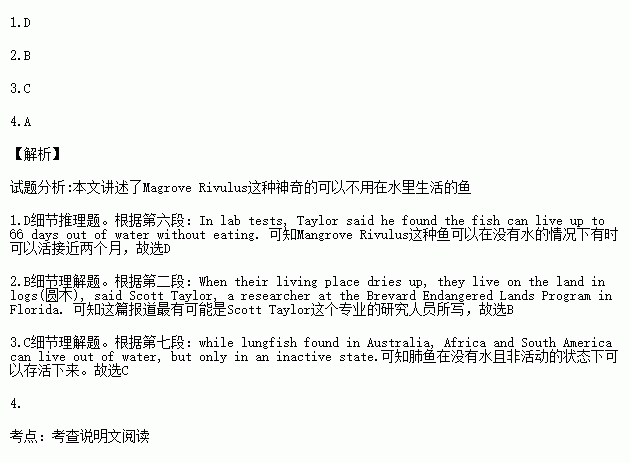题目内容
GUATEMALA CITY(Reuters)-----A fish that lives in mangrove swamps(红树沼泽)across the Americas can live out of water for months at a time, similar to how animals adapted to land millions of years ago, a new study shows.
The Magrove Rivulus, a type of small killifish, lives in small pools of water in a certain type of empty nut or even old beer cans in the mangrove swamps of Belize, the United States and Brazil. When their living place dries up, they live on the land in logs(圆木), said Scott Taylor, a researcher at the Brevard Endangered Lands Program in Florida.
The fish, whose scientific name is Rivulus marmoratus, can grow as large as three inches. They group together in logs and breathe air through their skin until they can find water again.
The new scientific discovery came after a trip to Belize.
“We kicked over a log and the fish just came crowding out,” Taylor told Reuters in neighboring Guatgemala by telephone. He said he will make his study on the fish known to the public in an American magazine early next year.
In lab tests, Taylor said he found the fish can live up to 66 days out of water without eating.
Some other fish can live out of water for a short period of time. The walking catfish found in Southeast Asia can stay on land for hours at a time, while lungfish found in Australia, Africa and South America can live out of water, but only in an inactive state. But no other known fish can be out of water as long as the Mangrove Rivulus and remain active, according to Patricia Wright, a biologist at Canada’s University of Guelph.
Further studies of the fish may tell how animals changed over time.
“These animals live in conditions similar to those that existed millions of years ago, when animals began making the transition (过渡) from water onto land,” Wright said.
1.The Mangrove Rivulus is a type of fish that __________.
A. likes eating nuts
B. prefers living in dry places
C. is the longest living fish on earth
D. can stay alive for two months out of water
2.Who will write up a report on Mangrove Rivulus?
A. Patricia Wright B. Scott Taylor
C. Scientists from Belize D. Researchers in Guatemala
3.According to the text, lungfish can____________.
A. breathe through its skin
B. move freely on dry land
C. remain alive out of water
D. be as active on land as in water
4.What can we say about the discovery of Mangrove Rivulus?
A. It was made quite by accident
B. It was based on a lab test of sea life
C. It was supported by an American magazine
D. It was helped by Patricia Wright
 名题金卷系列答案
名题金卷系列答案
